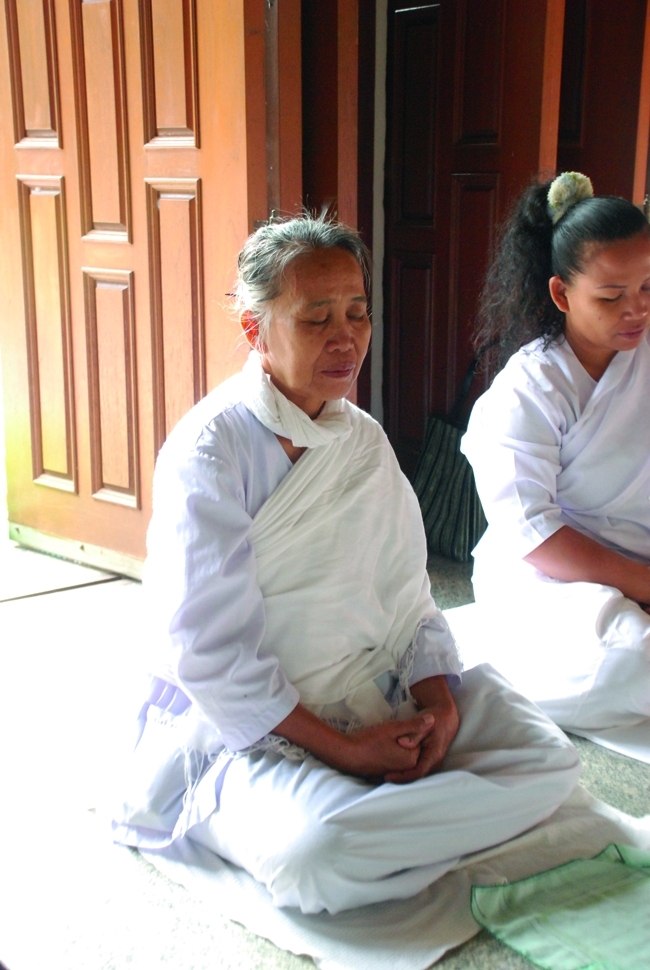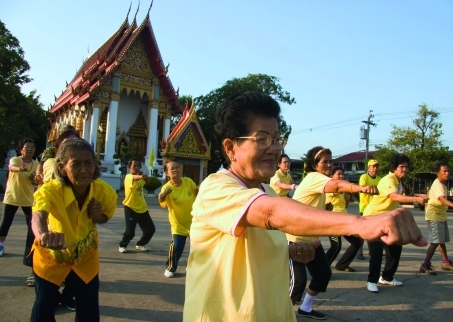Abstract
Shrinking fertility rates and longer lives are changing the demographic landscape of countries worldwide, challenging not only the way we think about how to fund care for older people, but attitudes to ageing itself. Gary Humphreys reports.
“In a way we are the victims of our own success.”
Viroj Tangcharoensathien
“We want to be stretching life in the middle, not just at the end.”
John Beard
The population of Thailand is getting old. According to Viroj Tangcharoensathien, senior adviser of Thailand’s International Health Policy Programme, at the present time, just under 11% of the Thai population is over 60 years of age and the trend is rapidly rising. “The proportion of older persons in the total population is expected to reach 14% in 2015, 19.8% in 2025 and nearly 30% by 2050,” he says. Driving the trend is a combination of falling fertility rates (thanks in part to government provision of family planning services) and improvements in health especially of women and infants. “In a way we are the victims of our own success,” says Tangcharoensathien, noting that contraception prevalence has jumped from 15% in 1970 to around 80% at present, while life expectancy has risen from 56.2 and 51.9 years for women and men respectively in the mid 1960s to around 75.7/69.9 years today.
So in what way is Thailand a victim? After all, as John Beard, director of WHO’s Department of Ageing and Life Course, points out, Thailand’s success story is a cause for celebration: “We are basically seeing more children surviving childhood and more women surviving childbirth but also getting more control over their fertility,” he says. But while that is certainly true, Thailand’s ageing population also represents an enormous challenge. And Thailand is not the only victim of success, a fact confirmed by a recent report submitted to the United Nations Human Rights Council stating that the 60-years-and-plus population is the fastest growing of all demographic segments. The report, submitted by Anand Grover, special rapporteur on the right to the highest standard of mental and physical health, in July last year states that by 2050 one in five people will join their ranks and that the 60-years-and-plus group will number around one billion by the end of the decade.
And while we tend to think of shrinking birth rates and ageing populations as mainly an issue for high-income countries, as the United Nations report points out, this demographic shift is now being felt most acutely in developing countries, particularly in Asia, where more than half of the world’s over-60s (400 million) currently reside. “The demographic changes being experienced by low- and middle-income countries today are happening much more quickly than was the case for Europe and North America,” Beard says, noting that in the past 10 years or so a number of Asian countries, including China, Indonesia, Japan, Myanmar, the Republic of Korea, Singapore, Thailand and Viet Nam have seen fertility rates drop below the total fertility rates recorded in European countries, and in many instances close to or below the level needed to replace their populations.
The increasingly large number of older people – aged 60 years and plus – is thus dependent on a proportionately shrinking resource, that is on younger people and, in particular, younger relatives. In Thailand, for example, as in many other developing countries, children are by far the most common source of income for the older people, and expectations of filial support in old age are shared widely by the current generation of adults. Given the importance of family for providing or helping with long-term care for the elderly, and the fact that as a resource this is rapidly shrinking, what can governments do to avoid a catastrophic break-down in elder care in the coming decades?
In Thailand, the government has taken a number of steps at the national level to direct more resources into supporting older people, including the launch of a National Pension Fund in March 2011. The hope is that the expansion of the retirement pension among insured workers under the social security system and savers under a planned National Savings Scheme will be enough to counterbalance the likely loss of filial support. Judging by the experience of other countries, such schemes alone may not be sufficient.
So what is to be done? For Beard, what is needed is a fundamental rethinking of our attitudes to older people, particularly the notion that older people constitute a “social burden". Beard would like to see a refocusing on the continuing contribution of older people to society, as part of what WHO calls an ‘active ageing’ approach, one of the key components of which is maintaining good health beyond 60. While access to primary health care is crucial in maintaining good health into older age, adopting healthy living practices throughout life is just as important.
Healthy living for older people is a core aspect of Brazil’s response to the challenge of population ageing according to Jarbas Barbosa, Secretary of Health Surveillance at the Ministry of Health. At present Brazil’s elderly population stands at 14 million, or just under 8% of the total 195 million, but by 2050 is forecast to reach 49 million, a 300% increase, Barbosa says. One way the country hopes to cope is by encouraging physical activity among the elderly. The current 10-year health plan (2011–2021) includes support for municipalities to implement 4000 ‘health academies’, public gymnasiums where people, including older people, can get physical exercise: “The idea is that in 2015, in three years time, we will have 4000 spaces like this, one located in each municipality – in the poor neighbourhoods, in big cities – to guarantee that old people and others have a place under supervision to practise physical activity,” Barbosa says, adding that this is one component of the national plan to combat noncommunicable diseases which also includes health promotion and health care for people living with chronic conditions, such as diabetes, cancer and hypertension.
But as Beard explains, active ageing is not just about physical activity and health care, but includes continuing participation in social, economic, cultural and civic affairs. To achieve these things countries will have to do a great deal more than merely encourage people to get on their bikes or go to the gym: to become a reality active ageing requires a wholesale rethinking of the role of old people in society. “We tend to think of life in very linear terms – go to college, get a job and then retire at 60,” Beard says. “This way of thinking may have been appropriate for the 20th century, but I think it is very restrictive. Older people want to continue to participate. Sticking to these outdated ideas of ageing is limiting our ability to create the types of lives we may want to live in the 21st century. Less-developed countries, in particular, may want to invent entirely new models.”
But however active and healthy people can remain after 60, there comes a point where older people start to become frail and lose autonomy. Some kind of care system has to be in place and that system has to be funded. Where cognitive impairment is part of a person’s declining health, the need for care and funding becomes acute. Not only is dementia more common in older people it has, so far, defied both prevention and treatment. “Unless we find new approaches, we know that population ageing will be accompanied by an increase in people with cognitive decline and dementia,” Beard emphasizes, adding that dementia is a “totally neglected issue".
Martin Prince, a professor of epidemiological psychiatry at King’s College, London University, also laments the lack of research on dementia. “Relatively speaking, there is much less investment in research into dementia, given its burden, compared with, for example, research into cancer and cardiovascular disease, and this is short-sighted,” he says, noting however that improved understanding of the neurobiology of the disease, and pharmaceutical company investment in anti-dementia drug development are reasons for hope. But despite some encouraging developments, it appears that dementia is likely to be a huge problem in the future, particularly for low and middle-income countries which, as Prince notes, by 2050 are forecast to be home to around 75% of people living with dementia.
So ageing presents some formidable challenges, particularly with regard to the way we end our lives, but for Beard it would be a mistake to let the last years define the issue as a whole. “Yes, we need to make sure that long-term and palliative care is accessible for those who need it at the end of life,” he says. “But we also need to reinvent the way we think about ageing itself. We want to be stretching life in the middle, not just at the end. This means keeping people healthy for as long as possible, and giving them the opportunity to do the things they want and that society needs.”

Elderly woman practising meditation at Nong Pa Pong Temple, Ubon Ratchatani province Thailand
Courtesy of the National Health Security Office, Thailand
Older people in Thailand working out
Vinai Dithajohn/OnAsia.com/WHO



